The book tour for KILL’T DEAD OR WORSE begins today! Check out these blog stops for excerpts and interviews:
The Avid Reader – Excerpt
Strand’s Simply Tips – Interview
Books, Dreams, Life – Spotlight
Field of Bookish Dreams – Excerpt
Drum Roll!!!! Here’s the cover for the first title, KILL’T DEAD OR WORSE, in the Nick Sibelius series.
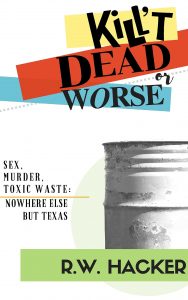
I got a chance to talk with the designer, Anna Hacker Downey, about her thoughts regarding the cover:
What was your inspiration for the cover design?
I listened to your thoughts, read the synopsis and pitch for the book, and spent time with you discussion your goals and the tone you wanted the book to have.
Say a little more about tone.
The Sibelius series is a crime story, but it’s full of humorous eccentric characters along the lines of one of Elmore Leonard’s or Carl Hiaasen’s novels. So the goal was to project some of the humor in the cover which is accomplished with the way the title teeters across the page. The bold bands of color give it the feel of jazz poster or the title credits to some of the humorous crime films of the late 50’s and 60’s. The barrel is a hint to what may be worse than death in the story.
KILL’T DEAD OR WORSE is available today at Amazon. A paperback edition will be coming live later in December.
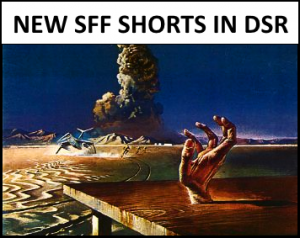 I’m very pleased to announce the latest issue of the Del Sol Review has gone live. The issue focuses on speculative fiction, as well as poetry. Come check it out!
I’m very pleased to announce the latest issue of the Del Sol Review has gone live. The issue focuses on speculative fiction, as well as poetry. Come check it out!
I’m pleased to announce my short story, SWING THING, has been published as an ebook on Amazon and is available for FREE from May 10-13!
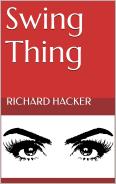
The woman I’ve been stalking for the last week has, once again, followed her usual route by a little cafe on 70th. Petite, shoulder length brunette hair, hips doing that swing thing women do, wearing a baby blue sports bra and a pair of black skin-tight capris. Yeah. I know they’re called capris. Anyway, those tights definitely helped out with the swing thing. Her butt looked solid, like two firm melons in a cluster. Damn.
When a hit man thoughts stray to the woman he’s been paid to kill, his life takes an unexpected turn. Can a hit man change his ways or will death be his constant companion?
Sometimes what you never thought you’d ever see happens right in front of you.
Like many of us, I have watched Amazon enter the marketplace, devouring small, independent bookstores and crushing the big box stores as well. Amazon can sell just about anything to anyone and get it there in two days for free. Sounds much more like an organization focused on generating revenues and quarterly earnings and not so much on literature. And so, I have approached Amazon with caution, trying to stay open-minded, but leaning to the side of the independents. Recently I visited a place I never thought could possibly exist. An Amazon brick and mortar book store. I walked in wanting to not like the place. However, I have to say, I left pretty impressed. But let me give you a bit more background on where I’m coming from and then I’ll give you a quick tour.
Recently I visited a place I never thought could possibly exist.
An Amazon brick and mortar book store.
When Champagne Books published my first novel, TOXIC RELATIONSHIP, I was a happy little author. I could go to the online stores at Amazon, Kobo, Apple, and Barnes & Noble to find the ebook available. After a sufficient number of ebook titles sold, the publisher put out a paperback edition as well. And so, with books in hand, I went to Barnes & Noble in Austin where I had lived for many years, and the setting for the novel. I planned to speak with the manager, who would happily have an Austin author (yes, I had moved to Seattle, but just by a couple of years) come into his store to promote the novel and do a signing. After offering my best pitch, the manager gave me an unexpected answer. “No.” Champagne didn’t work through the major distributors for paper books and even though the book had an ISBN number and I had a box of books I would happily sell and have B & N take it’s cut–no go. And furthermore, if someone saw the book and bought it online at the Barnes & Noble.com, the manager’s store would not get anything out of the sale. And so he reiterated, “No.” I recall leaving wondering how long B & N would survive with such a fragmented business plan.
And now we come to the present day in Seattle as I wander into the very first Amazon brick and mortar bookstore.
When I walked into the store, a staff member greeted me, Apple Store style, with a welcome and giving me a quick lay of the land. Moving deeper into the space, the first thing I noticed was the orientation of the books, cover out, rather than the typical spine out. Stacking books on shelves spine out allows a store to have more titles in stock, but seeing the cover and just having fewer books in the line of sight at one time made for a more pleasant and reflective shopping experience. And in front of each book is a brief description. Obviously, Amazon can only display a few thousand books in this manner, but there as certain feeling of abundance about it. They know and I know there are millions of titles out there, accessible online, but here is a selection of the current crop. Want to find out about more titles for an author? Explore other authors in the genre? Just pull out your phone and get online.
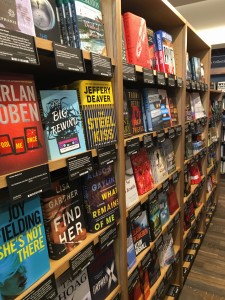
One of the two stacks of sci-fi fantasy shelves. Each book is cover out and has a brief description below.
Or wander over to the ample reading space, pick up a spare Kindle and check out a book or a magazine or a game.

The reading area has a wall of cushioned bench seating. Kindles are accessible on the small tables.
The store is laid out in the typical fashion by genre and sub genre and a children’s books area with bean bag chairs and tables. The cover out display here helps an adult scan the titles as you look for the right book for your child or grandchild.
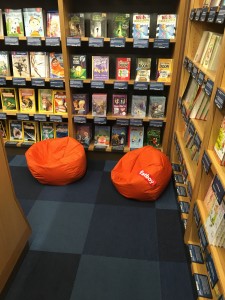
Kid sized bean bag chairs and a kid sized table and chairs provides some reading space for children.
So I walked in not wanting to like this too much. But I’ve got to say, as you would expect a master retailer to do, they pretty much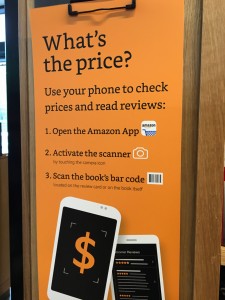 nailed the brick and mortar bookstore. The openness of the place is striking. Here’s the vibe of the store: Come in. Browse. Take pictures. Scan codes. Compare prices anywhere. Pick up a book, wander over to a bench, and read. Grab a Kindle and explore. Buy something here, buy it online, or don’t buy anything. Thanks for hanging out with us. Aren’t books cool?
nailed the brick and mortar bookstore. The openness of the place is striking. Here’s the vibe of the store: Come in. Browse. Take pictures. Scan codes. Compare prices anywhere. Pick up a book, wander over to a bench, and read. Grab a Kindle and explore. Buy something here, buy it online, or don’t buy anything. Thanks for hanging out with us. Aren’t books cool?
I’m a big ebook reader, so most of my books are digital these days, but I still appreciate the the feel of a good book, the smell of books on a shelf, and I still have so many books stacked every which way on too many bookshelves in my house that I could open my own library. I’ll still buy online or at my local independent. But when I’m in the vicinity of the Amazon store, I’ll probably drop in, browse, maybe buy something there or online and just take in the ambiance.
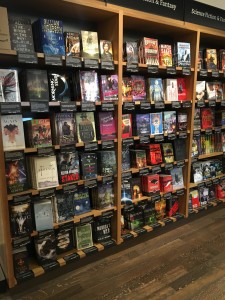
I lived in Texas most of my life in land locked Austin –although there are some nice lakes. Coming to Seattle and the Pacific coast has exposed me to all sorts of new bits of history and tech unique to area or to life on or by the ocean. Just last week while visiting San Diego I dropped into the Maritime Museum of San Diego, which features ships from a replica 16th century Spanish ship to the ship used in Master and Commander, a yacht from the early 20th century and a navel research submarine. In addition, the museum, housed in a ferry boat, has static displays of maritime history of Southern California. It was among the ship models, newspaper clippings and old photos that I came across something unusual. The Benson Raft.

The raft is a cigar-shaped pile of anywhere between 4 and 8 million board feet of logs cradled together with lumber chains. A Portland, Oregon lumber baron, Simon Benson, used these rafts to move logs from the Columbia River down the coast all the way to San Diego. The size of a typical raft was immense. 1000 feet long, 55 feet wide with a draft (the bit under the waterline) of 28 feet. Think about it. A cigar of logs longer than three football fields being pulled by a tug! The photos usually have two or three tripods holding a lantern positioned along the length, I imagine for night visibly to passing ships. And some of the photos show men on the raft with poles while this thing is underway. I suppose they were there to ensure the logs maintained position, but I have a feeling turnover was quite high given the many opportunities to be either crushed, drowned or crushed and drowned simultaneously.
You can read more about the Benson Raft at the Oregon History Project
If you’re into jazz and if you’re into vocal jazz, you know Al Jarreau. I came across this bit of video from a German telecast in 1976 which gives us all a glimpse at this artist’s brilliance. Take Five, the Dave Brubeck jazz standard is taken to new and wonderful places. I love his percussive, rhythmic dance to the music, his voice a delightfully flexible instrument soaring and flitting in this creative tour de force. This will blow your mind. Enjoy.
Al Jarreau sings Take Five.